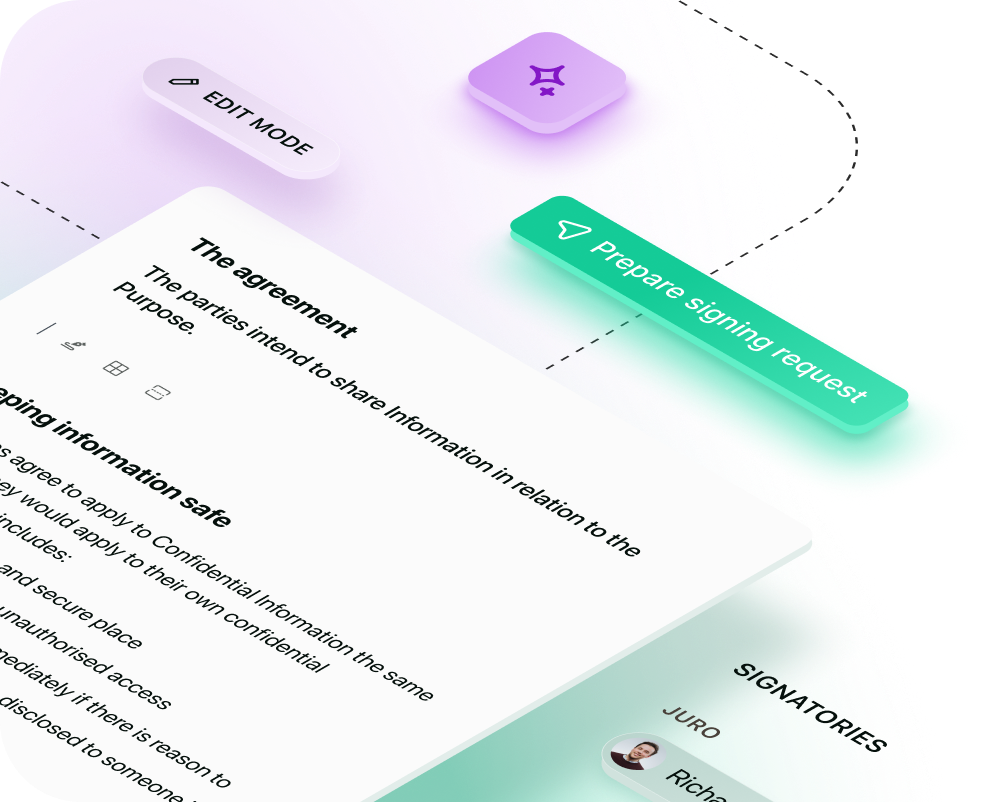Solutions
Customer Support
Resources
Use this EULA template to define the rights and limitations for software users, ensuring protection for creators and clarity for end-users.




An end user license agreement (EULA) is an important contract in the software industry, as it sets out the terms and conditions under which end users may use a piece of software. EULAs are critical for protecting the intellectual property rights of software developers, managing legal risks and ensuring that users understand their rights and obligations when using the software.
This article covers the essentials of EULAs, their purpose, management, and the advantages of automating them with Juro’s contract management platform.
An end user license agreement is a legal contract between a software provider (licensor) and the end user (licensee). The EULA sets out the rights and responsibilities of both parties regarding the use of the software. It typically includes:
The primary purpose of an end user license agreement is to protect the intellectual property of the software provider while clearly defining the user’s rights and restrictions. It serves several key functions:
End user license agreements are typically managed by the legal and IT departments within an organization. Legal teams draft, review and update EULAs to ensure they are legally sound and enforceable. They also handle disputes and compliance issues related to the agreements. IT teams implement and enforce EULAs within the software. This includes embedding license checks within the software and monitoring compliance. Compliance teams make sure that all aspects of the EULA comply with relevant laws and regulations, including data protection and consumer rights.
EULAs are used when software providers grant users the right to use their software under specific conditions. They outline the terms and conditions under which the software can be used, establishing the legal relationship between the software provider and the user. Here are common scenarios where EULAs are employed:
EULAs are standard for commercial software applications – whether they are sold as standalone products or bundled with hardware.
For cloud-based services and applications, EULAs define the usage terms, data rights and limitations of the service.
Mobile application developers use EULAs to set the terms for app usage, including restrictions on copying, modifying or redistributing the software.
Game developers use EULAs to protect their intellectual property and set rules for how the game can be played and shared.
EULAs are used in beta testing to inform users of the software’s pre-release status and to limit liability for any potential issues.
While not always termed as EULAs, open-source licenses (such as GPL, MIT, or Apache) serve a similar purpose by defining how the software can be used, modified and distributed.
Businesses that purchase software for internal use often agree to EULAs to ensure compliance with licensing terms and to receive support and updates.
Even free software often comes with EULAs to limit the provider’s liability and to set conditions for use and redistribution.

A comprehensive end user license agreement template should cover the following elements:
Introduction. Title, date and identification of parties involved.
Grant of license. Description and scope of the license granted.
Restrictions. Prohibited uses and limitations on software modification.
Intellectual property rights. Ownership and rights retained by the provider.
User responsibilities. Compliance requirements and confidentiality.
Updates and upgrades. Terms for updates and associated costs.
Term and termination. Duration, termination conditions and consequences.
Warranty disclaimer. Statement of “as is” provision and warranty disclaimers.
Limitation of liability. Limits and exclusions of the provider's liability.
Indemnification. User’s agreement to indemnify the provider.
Governing law and dispute resolution. Applicable law and dispute resolution methods.
Entire agreement. Statement of the EULA as the entire agreement and amendment clauses.
Acceptance. Description of how the user accepts the terms.
Contact information. Provider’s contact details for inquiries.
Managing EULAs manually typically involves several steps:
This manual process can be cumbersome, inefficient and error-prone – often leading to delays, miscommunication and increased risk of non-compliance.
Juro can streamline the management of end user license agreements through its AI-native, collaborative and integrated contract management platform. By leveraging Juro's capabilities, organizations can enhance the efficiency, accuracy and compliance of managing end user license agreements. Here’s how:
Store all EULAs in one secure, dynamic contract repository to ensure easy access, organization and retrieval.
Use automated contract templates to quickly draft EULAs, reducing manual effort and ensuring consistency across all agreements.

Facilitate collaboration across legal and business teams with real-time editing and commenting, improving the efficiency of drafting and reviewing EULAs.
Set up automated workflows to streamline the approval process, ensuring that EULAs are reviewed and approved by the right stakeholders without delays.
Maintain version histories of EULAs, allowing easy tracking of changes and making sure that the most current version is always in use.
Integrate Juro with your existing software tools, enabling seamless contract management within the systems your teams already use.
Set up automated alerts for key dates – like renewal or termination deadlines – to ensure that no important dates are missed.
.avif)
Use Juro’s analytics to gain insights into contract performance and compliance to identify risks and optimize contract management processes.
Empower business teams to self-serve on creating and managing simple EULAs, freeing up legal teams to focus on more complex tasks.
Ensure compliance with legal standards and protect sensitive information with robust security measures and access controls.
Juro’s AI-native contract automation platform empowers all teams to create, agree, execute and manage contracts up to 10x faster than traditional tools. To find out more, hit the button below to book your personalized demo.
For SaaS contract templates, check out the ones below:
Juro is the #1-rated contract platform globally for speed of implementation.


Juro embeds contracting in the tools business teams use every day, so they can agree and manage contracts end-to-end - while legal stays in control.
Book your demo